A balanced diet is key for good health. Eating a variety of nutrient-rich foods helps your body work right.Adding simple steps to your day can make healthy eating easy. This article will guide you to a balanced diet and better health.
Key Takeaways
- Eat a variety of foods from all food groups.
- Incorporate nutrient-rich foods into your meals.
- Limit your intake of processed and high-calorie foods.
- Stay hydrated by drinking plenty of water.
- Consult a healthcare professional or a registered dietitian to create a personalized diet plan.
What a Balanced Diet Really Means for Your Health
Knowing what a balanced diet is key to making smart food choices. It gives your body the nutrients, vitamins, and minerals it needs. It’s not just about avoiding certain foods or following the latest trends. It’s about making a healthy eating plan that lasts.
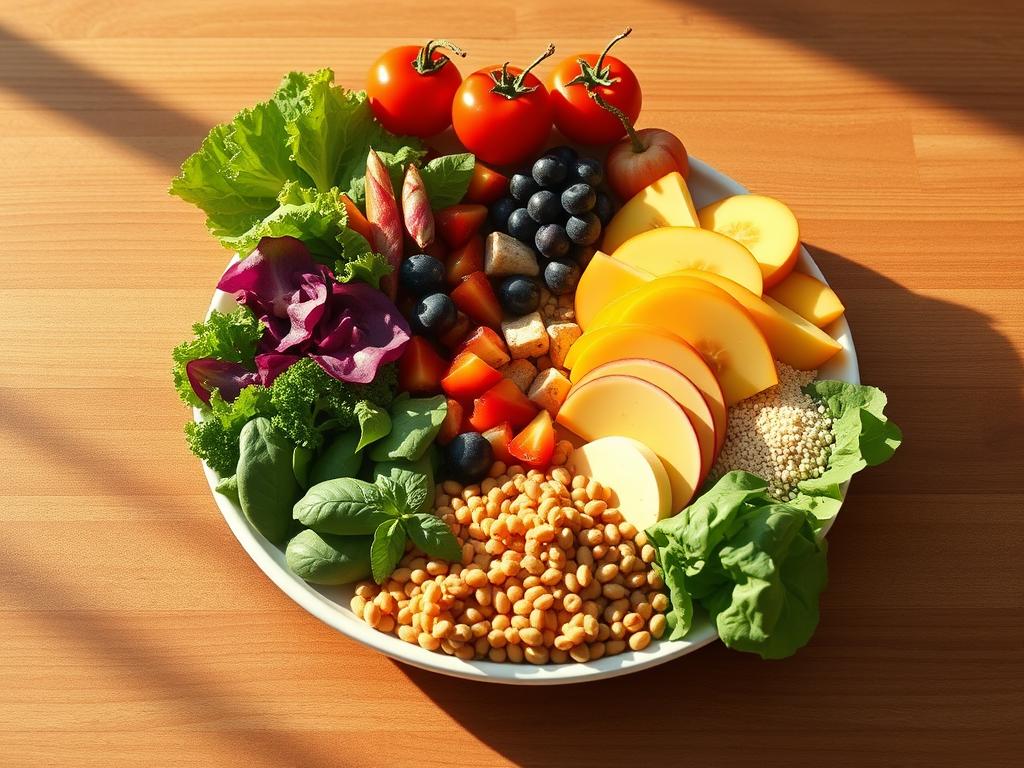
The Science Behind Nutritional Balance
Nutritional balance means eating a variety of foods from different groups in the right amounts. This mix is important because each nutrient has its own role in keeping you healthy. For example, carbohydrates give you energy, proteins help repair and build tissues, and fats support many bodily functions. Nutrition experts say a balanced diet should have all these nutrients for good health.
Common Misconceptions About Healthy Eating
Many think healthy eating means giving up food, but it’s really about making smart choices. Some believe a balanced diet is pricey or takes too much time. But with good meal planning, you can eat wholesome meals without spending a lot or cooking for hours. Remember, “Let food be thy medicine and medicine be thy food.” Good nutrition is an investment in your health.
Understanding a balanced diet helps you make better food choices and boosts your health. It’s about living a lifestyle filled with nutrient-rich foods, not strict diets.
The Remarkable Benefits of a Balanced Diet
A balanced diet offers many benefits for both body and mind. Eating a variety of whole foods like whole grains, fruits, and vegetables can greatly improve your health.

Physical Health Improvements
A balanced diet is key for weight management and good physical health. Eating the right amounts of nutrient-rich foods helps avoid obesity and health problems. Foods like brown rice and quinoa give you fiber, while fruits and veggies are packed with vitamins and minerals.
Mental Well-being Enhancement
Good food also boosts your mental health. Eating foods high in omega-3s, like salmon, and antioxidants from berries and greens, can lift your mood and lower stress. A healthy diet is essential for a happy, fulfilling life.
Long-term Disease Prevention
Another big plus of a balanced diet is preventing long-term diseases. Eating lots of whole grains, fruits, and veggies can lower your risk of heart disease, diabetes, and some cancers. Smart food choices lead to a healthier future.
Essential Nutrients for a Balanced Diet
Learning about essential nutrients is key to a balanced diet. It’s not just about what you eat. It’s about getting the right nutrients for your body’s health.
Macronutrients: Carbs, Proteins, and Fats
Macronutrients give you energy and help your body grow. They include carbs, proteins, and fats. You need them in big amounts.
- Carbohydrates: They give you energy. Find them in whole grains, fruits, and veggies.
- Proteins: They help build and fix tissues. You can find them in lean meats, fish, eggs, and beans.
- Fats: They help with energy and vitamin absorption. Healthy fats are in nuts, seeds, avocados, and olive oil.
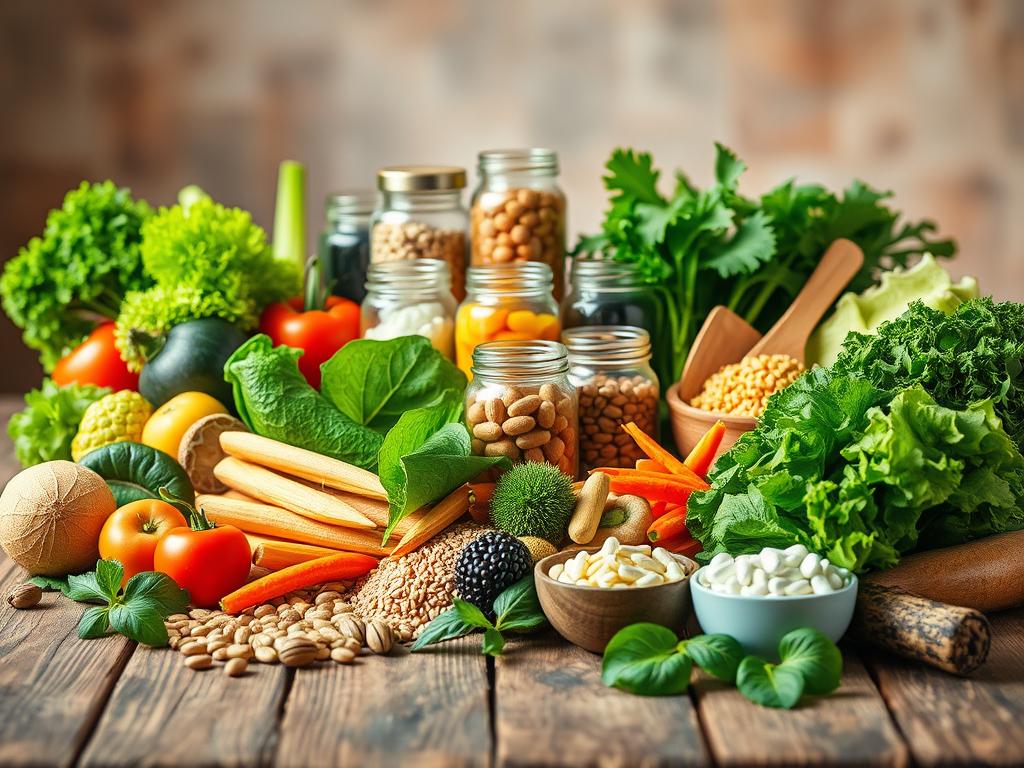
Micronutrients: Essential Vitamins and Minerals
Micronutrients are needed in small amounts but are very important. They include vitamins and minerals.
Key Vitamins for Optimal Health
Vitamins help with energy and keeping you healthy. Vitamin C boosts your immune system. Vitamin D is good for your bones.
Minerals Your Body Needs Daily
Minerals like calcium and iron are important. Calcium is for strong bones. Iron helps carry oxygen in your blood. Make sure you get enough through food or supplements.
| Nutrient | Function | Food Sources |
| Vitamin C | Immune function, antioxidant | Citrus fruits, strawberries, bell peppers |
| Calcium | Bone health | Dairy products, leafy greens, fortified foods |
| Iron | Oxygen transport | Red meat, poultry, fish, beans, lentils |
Building Your Plate: The Balanced Diet Framework
Getting a balanced diet is easier with the right meal planning tips. It’s all about knowing what makes up a healthy meal and how to mix it right.
Understanding the USDA MyPlate Guidelines
The USDA MyPlate guidelines make meal planning simple. They suggest dividing your plate into sections for different food groups. This way, you get a mix of nutrient-dense foods.
They say fill half your plate with fruits and veggies. Then, use one-quarter for protein and another quarter for whole grains.
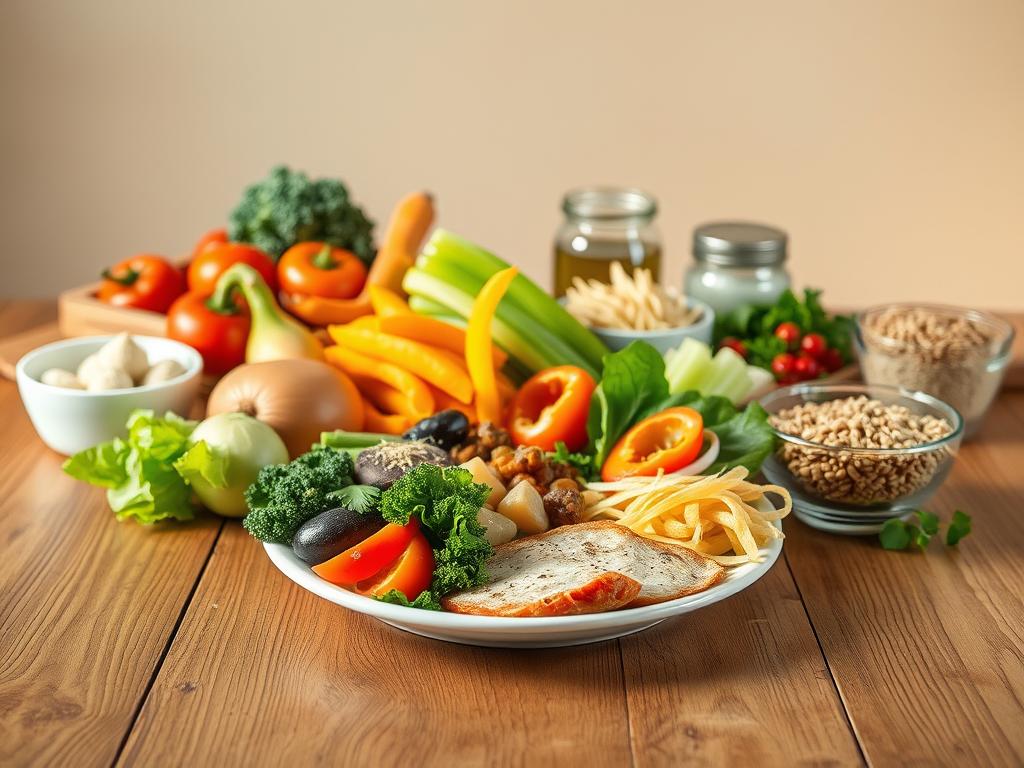
Alternative Dietary Frameworks That Work
While MyPlate is helpful, other diets can also lead to dietary balance. Some like the Mediterranean diet or plant-based eating. The important thing is to pick a diet that fits your life and gives your body the nutrients it needs.
Using these diets and focusing on nutrient-dense foods helps make meals that are good for your health.
Incorporating Whole Grains and Complex Carbohydrates
Adding whole grains and complex carbohydrates to your diet is easy and beneficial. Foods like brown rice, quinoa, and whole-wheat bread are full of fiber, vitamins, and minerals. They are nutritious and can be used in many meals.
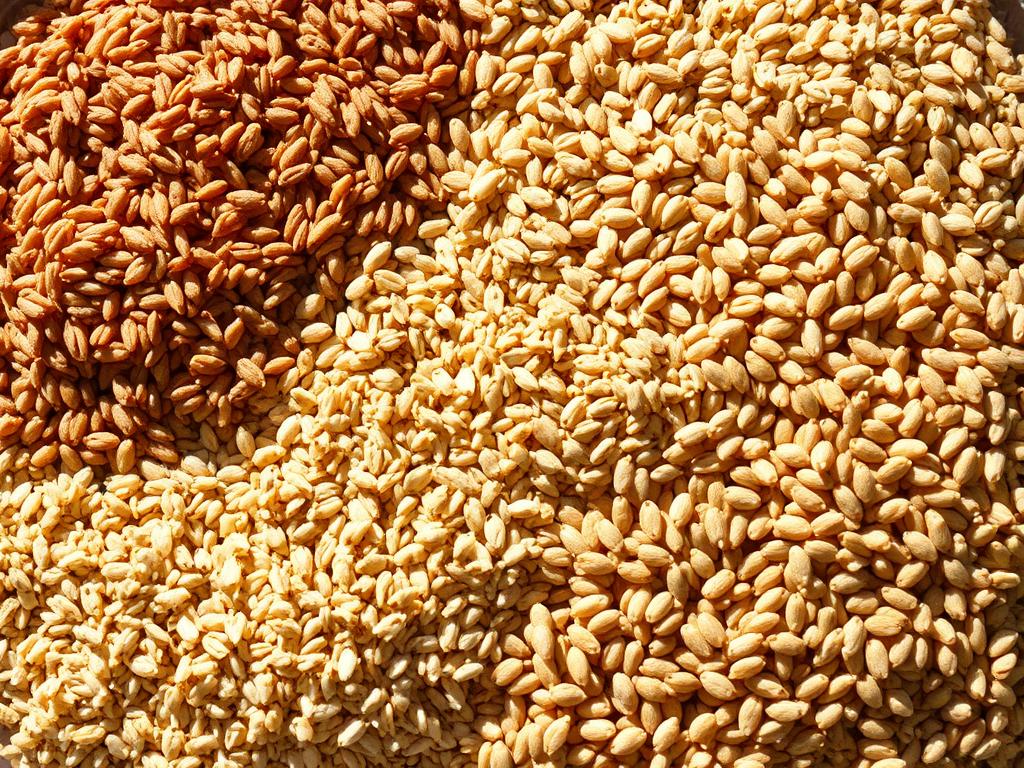
Best Sources of Healthy Carbohydrates
Healthy carbs come from whole grains, fruits, and vegetables. Grains like oats, barley, and whole-wheat pasta are high in fiber. Fruits and veggies, like apples, carrots, and broccoli, offer vitamins and minerals.
Proper Portions and Timing for Energy Balance
Knowing the right portions and when to eat is key for energy balance. Eating complex carbs all day keeps your energy steady. For example, oatmeal for breakfast or a quinoa salad for lunch can keep you energized.
| Food Group | Recommended Daily Intake |
| Whole Grains | 3-5 servings |
| Fruits | 2-3 servings |
| Vegetables | 3-5 servings |
Harvard’s School of Public Health says eating whole grains lowers heart disease, diabetes, and cancer risks. Adding whole grains and complex carbs to your diet is a big step towards better health.
Protein Sources for Every Dietary Preference
Whether you love meat or prefer vegan options, there’s a wide range of protein sources for you. Protein is key for building and fixing body tissues. It’s vital for staying healthy.
Knowing about different protein sources helps you choose better for your diet. You can get protein from animals and plants, each with its own benefits.
Animal-Based Protein Options
Animal proteins are complete, meaning they have all nine essential amino acids your body needs. Examples include:
- Lean meats like chicken, turkey, and beef
- Fish and seafood, such as salmon and shrimp
- Eggs and dairy products like milk and yogurt
These foods are not just high in protein. They also offer important nutrients like iron, zinc, and B vitamins.
Plant-Based Protein Alternatives
Plant-based proteins are found in many foods, including:
- Legumes like lentils, chickpeas, and black beans
- Nuts and seeds, such as almonds and chia seeds
- Tofu and tempeh
- Whole grains like quinoa and brown rice
Even though some plant proteins are incomplete, mixing different foods gives you all the amino acids you need.
Combining Proteins for Complete Nutrition
If you follow a plant-based diet, mixing proteins is key to getting all amino acids. For example:
| Protein Source 1 | Protein Source 2 | Complete Protein Example |
| Legumes (lentils) | Grains (rice) | Lentil soup with rice |
| Nuts/Seeds (almonds) | Legumes (chickpeas) | Hummus with almonds |
| Tofu | Vegetables (broccoli) | Stir-fry with tofu and broccoli |
By mixing these foods, you get a complete protein that supports your health.
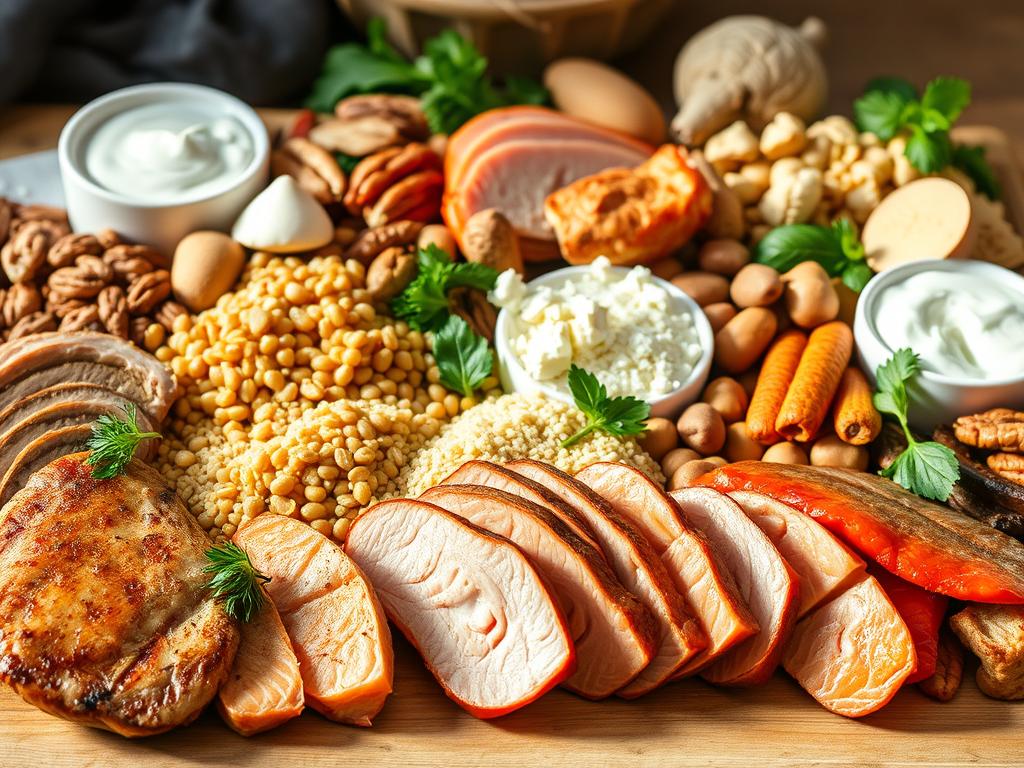
In conclusion, there are many protein sources for every diet. Understanding and using these options in your meal planning helps you get a balanced diet. This supports your health and well-being.
The Power of Fruits and Vegetables in Your Daily Diet
Eating a rainbow of fruits and vegetables is a simple yet effective way to improve your nutritional intake. These foods are packed with vitamins, minerals, and antioxidants that are essential for maintaining optimal health.
Eating the Rainbow: Why Variety Matters
Different colored fruits and vegetables provide different nutrients. For example, leafy greens are rich in iron and calcium, while orange vegetables are high in vitamin A. Eating a variety of colors ensures you get a broad range of nutrients.
Nutrient Breakdown by Color:
| Color | Primary Nutrients | Examples |
| Red | Vitamin C, Lycopene | Tomatoes, Strawberries |
| Orange/Yellow | Vitamin A, Vitamin C | Carrots, Bananas |
| Green | Iron, Calcium, Vitamin K | Spinach, Broccoli |
Fresh, Frozen, or Canned: Making Smart Choices
All forms of fruits and vegetables can be nutritious. Fresh produce is great when in season, but frozen and canned options are just as healthy and can be more convenient.
Seasonal Eating for Maximum Nutrition
Eating produce in season ensures you get the freshest, most nutrient-dense foods. It also supports local farmers and can be more budget-friendly.
Simple Ways to Add More Produce to Meals
Try adding fruits to your breakfast cereal or oatmeal, and include a variety of vegetables in your stir-fries and salads. You can also snack on raw vegetables with hummus or make a fruit salad as a quick dessert.

Healthy Fats: The Misunderstood Nutrient
Fats are not all the same, and some are good for us. Healthy fats are key for a balanced diet. They help our hearts, brains, and even our weight. But, many people don’t know what healthy fats are.
Distinguishing Between Good and Bad Fats
Some fats are bad, like saturated and trans fats in processed foods. But, unsaturated fats are good. You find them in avocados, nuts, seeds, and olive oil. These fats can lower cholesterol and fight inflammation.
Incorporating Healthy Fats Into Daily Meals
Adding healthy fats to your meals is easy. Try avocado on toast, nuts on salads, or olive oil for cooking. Here’s a quick guide:
| Food | Type of Fat | Health Benefit |
| Avocado | Monounsaturated | Heart Health |
| Nuts and Seeds | Polyunsaturated | Reduces Inflammation |
| Olive Oil | Monounsaturated | Lowers Cholesterol |
Dr. Walter Willett said, “The type of fat matters more than the amount.” Eating healthy fats can greatly improve your health.

Smart Meal Planning for Nutrient-Rich Eating
Meal planning is key to a balanced diet and better health. It helps you eat a variety of foods, saves time, and cuts down on waste.
Weekly Meal Prep Strategies
Good meal prep means planning meals around seasonal foods, cooking big batches, and portioning meals for the week. It saves time and keeps your diet balanced.
- Plan meals around seasonal produce for freshness and variety.
- Cook in bulk to save time and cut down on waste.
- Portion meals to keep your diet consistent.
Budget-Friendly Balanced Eating
Eating well doesn’t have to cost a lot. Plan meals, buy in bulk, and choose seasonal produce to eat healthy on a budget.
| Budget Tip | Description | Savings Potential |
| Buy in Bulk | Purchase non-perishable items in bulk to reduce cost per unit. | Up to 30% savings |
| Shop Seasonally | Choose produce that’s in season for better prices. | Up to 20% savings |
| Plan Meals | Plan your meals around what’s on sale to reduce grocery bills. | Up to 15% savings |
Time-Saving Tips for Wholesome Meals
Making healthy meals doesn’t have to take a lot of time. Batch cooking and smart shopping can make kitchen time shorter.
Batch Cooking Fundamentals
Batch cooking means making big batches of food that can be reheated or used in different meals. It’s great for those with busy lives who want to eat healthy.
Smart Grocery Shopping Lists
Make a smart shopping list based on your meal plan. It helps you avoid buying things you don’t need, saving time and money.
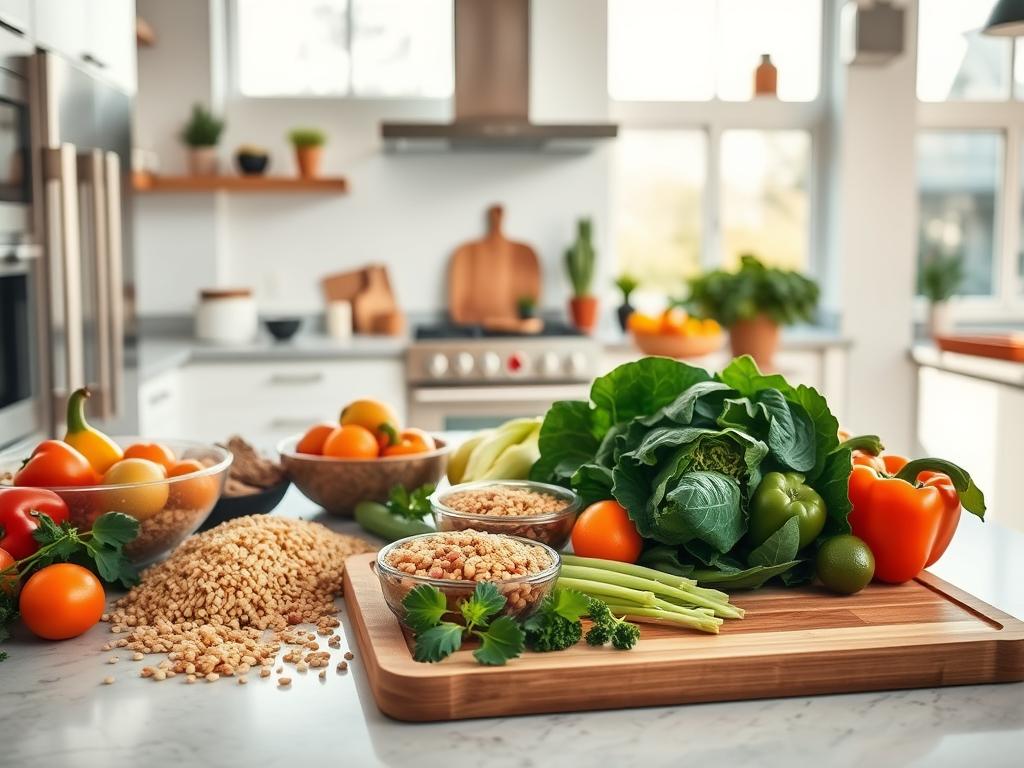
Navigating Special Dietary Needs While Maintaining Balance
It’s possible to have a balanced diet even with special dietary needs. You just need to make some smart changes. If you have food allergies or follow a certain diet, you can still get all the nutrients you need.
Balanced Eating with Food Allergies or Restrictions
Managing food allergies or dietary restrictions means finding nutrient-dense foods that fit your diet. For example, if you can’t have dairy, try non-dairy milk like almond or soy milk. It’s also good for calcium.
People with gluten intolerance can eat gluten-free grains like quinoa or brown rice. Always check food labels for hidden allergens or ingredients. This helps keep your diet balanced.
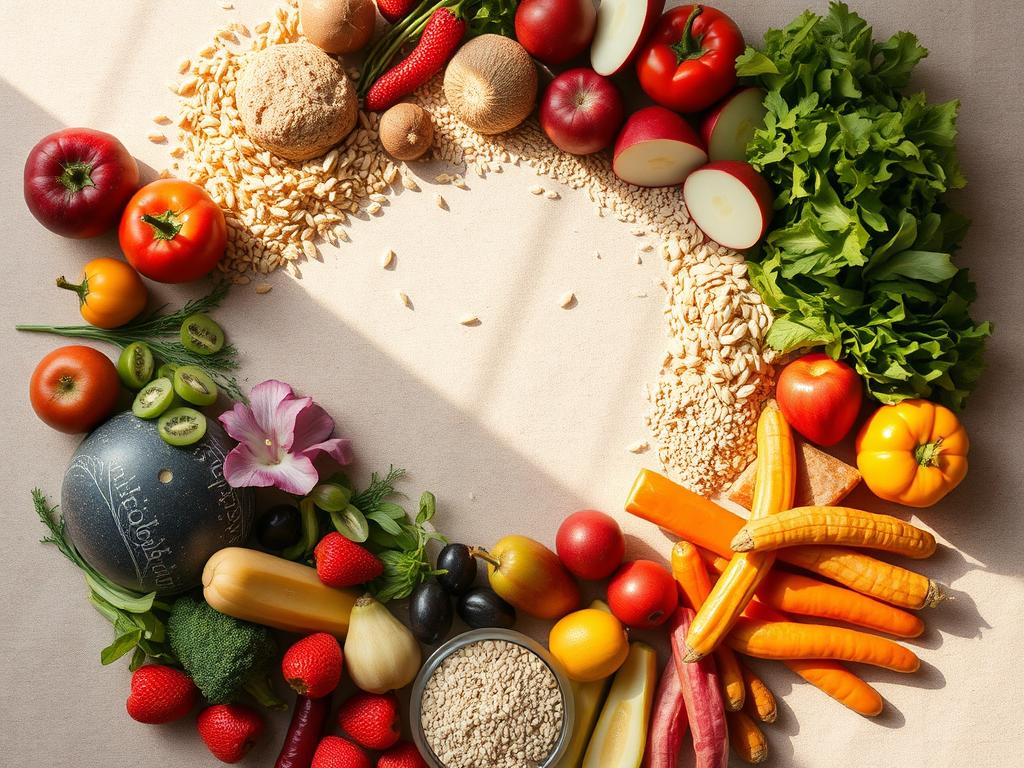
Adapting Balanced Diet Principles to Different Lifestyles
Adapting to different lifestyles, like veganism or vegetarianism, requires careful planning. Vegans, for instance, need to watch their vitamin B12 intake since it’s mostly in animal products. They can eat fortified foods or take supplements.
By eating a variety of balanced meals and being mindful of your eating habits, you can meet your nutritional needs. You won’t feel like you’re missing out.
Overcoming Common Obstacles to Balanced Eating
Maintaining a balanced diet can be tough, especially with everyday challenges like dining out and managing cravings. But, you can beat these obstacles and eat well.

Dining Out Without Compromising Nutrition
Eating out doesn’t have to ruin your healthy eating plans. Choose dishes with lots of veggies, lean proteins, and whole grains. A nutrition expert advises to watch portion sizes and avoid too many high-calorie foods.
Look for grilled, baked, or steamed options on menus. And don’t be shy about asking for special diet requests.
Managing Cravings and Emotional Eating
Cravings and emotional eating can block your path to balanced eating. Find out what triggers your cravings and find better ways to deal with them. Try going for a walk or deep breathing exercises.
Keeping a food diary can also help you understand your eating habits. This way, you can make better choices.
Staying Consistent During Busy Periods
Busy times can make it hard to eat well. But, with some planning, you can stay on track. Prepare healthy meals in advance and have nutritious snacks ready.
This way, you won’t fall back on unhealthy convenience foods. By focusing on your health and making smart food choices, you can keep a balanced diet even when life gets crazy.
Conclusion: Sustaining Your Balanced Diet Journey
Learning about a balanced diet is a big step towards a healthier life. It’s about knowing the value of nutrient-rich foods and adding wholesome meals to your day. This puts you on the path to better health.
Keeping up with a balanced diet takes dedication, but it’s worth it. By always choosing healthy eating, you’ll see big improvements in your health.
Remember, it’s about progress, not being perfect. Be flexible and don’t stress over mistakes. Over time, healthy eating will become easy, and you’ll enjoy the benefits of a balanced diet for a long time.
By following the tips in this article, you’ll be able to make choices that help your health. Start now and see how a balanced diet can change your life.
FAQ
What is a balanced diet, and why is it important?
A balanced diet includes a variety of foods from all groups. It gives the body the nutrients it needs for health. Eating well helps keep you physically and mentally strong and can prevent diseases.
How can I achieve a balanced diet?
To get a balanced diet, eat whole, nutrient-rich foods like fruits, veggies, whole grains, lean proteins, and healthy fats. Cut down on processed and high-calorie foods. Watch your portion sizes too.
What are some common misconceptions about healthy eating?
Some think healthy foods are boring or taste bad. Others believe a balanced diet means giving up favorite foods. But, healthy eating can be tasty and varied. It’s about making lasting changes.
How can I incorporate more fruits and vegetables into my diet?
Add different colors to your plate to eat more fruits and veggies. Try new ways to cook them, like roasting or grilling. Include them in your meals and snacks.
What are some tips for meal planning on a budget?
Plan meals around what’s in season to save money. Use coupons and shop sales. Cooking in bulk and using leftovers can also help.
How can I stay on track with my balanced diet when dining out?
Choose restaurants with healthy options when eating out. Be careful of portion sizes. Pick dishes that are nutritious but low in bad stuff like added sugars and unhealthy fats.
What are some strategies for managing cravings and emotional eating?
Identify what makes you crave certain foods. Stay hydrated. Find healthy ways to satisfy cravings. Mindful eating, keeping a food diary, or getting help from a dietitian can also help.
How can I maintain a balanced diet during busy periods?
Plan meals ahead and prep them when you can. Keep healthy snacks ready. Simplify meals, use a slow cooker, or choose nutrient-rich convenience foods.
